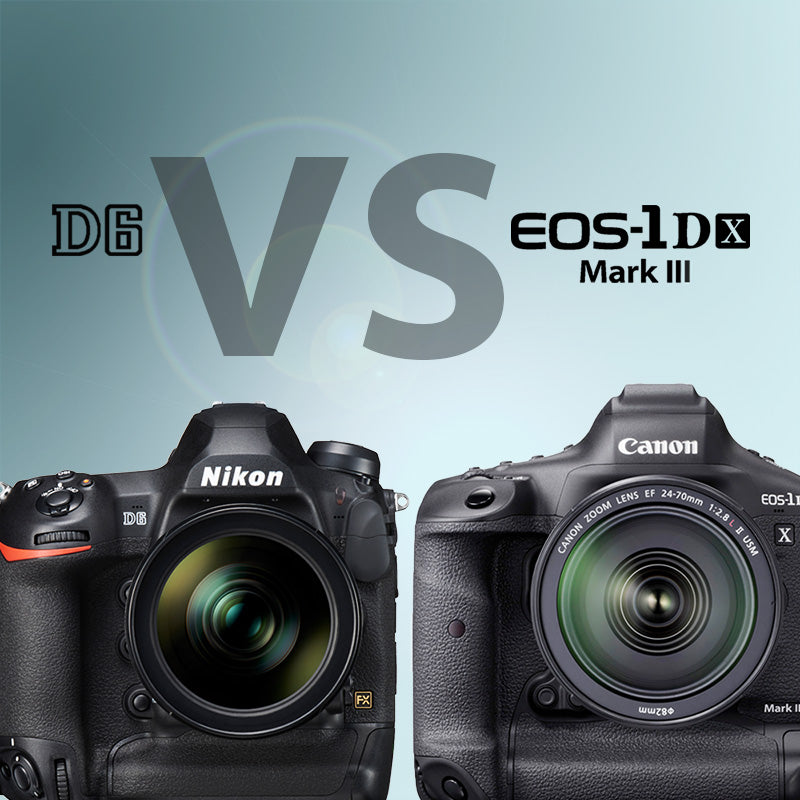The Nikon D6 was announced on February 12, 2020, a month and six days after the release of its rival the Canon 1D X Mark III. Both cameras are each brand's professional-level camera geared toward sports and wildlife photographers. With the recent release of both, we wanted to compare the two in terms of the specifications, features, appearance and advantages. So, let's start with the specification chart below:
The Nikon D6 vs. Canon 1D X Mark III Specification Chart
|
Camera Feature |
Nikon D6 | Canon 1D X Mark III |
| Mount Type | F Mount | EF Mount |
| Sensor Resolution | 20.8 MP | 20.1 MP |
| Sensor Type | CMOS | CMOS |
| Sensor Size | 35.9mm x 23.9mm | 36 x 24mm |
| Low Pass Filter | Yes | Yes |
| Viewfinder Magnification | .72x | .76x |
| Image Size | 5,568 x 3,712 | 5,472 x 3,648 |
| Image Formats | RAW, JPEG | RAW, JPEG, HEIF |
| Image Processor | EXPEED6 | DIGIC X |
| Viewfinder Type | Pentaprism | Pentaprism |
| Native ISO Sensitivity | 100-102,400 | 100-102,400 |
| Boosted ISO Sensitivity | 50, ISO 204,800-3,280,000 | 50, ISO 204,800-819,200 |
| Dust Reduction/Sensor Cleaning | Yes | Yes |
| Calibrations | Yes | Yes |
| Built-in Flash | No | No |
| Storage | 2x CFexpress Type B, XQD | 2x CFexpress Type B |
| Continuous Shooting Speed | 14 FPS (optical viewfinder) | 16 FPS (optical viewfinder) |
| Continuous Shooting Speed | 10.5 FPS (Live View) | 20 FPS (Live View) |
| Buffer Size | 200 | 1000 |
| Max Shutter Speed | 1/8000 to 900 sec | 1/8000 to 30 sec |
| Continuous Shooting | 14.3 seconds | 62.5 seconds |
| Shutter Durability | 400,000 cycles | 500,000 cycles |
| Number of AF Points | 105 AF points, 105 cross-type | 191 AF points, 90 cross-type |
| AF Detection Range | -4.5 to +20 EV | -4 to +21 EV |
| Smallest AF Detection Aperture | f/8 | f/8 |
| Video Max Resolution | 3,840x2,160 (4K UHD)/ 30 FPS | 5,472 x 2,886 (5.5K)/ 59.94 FPS |
| HDMI Output | 4:2:2, 8-bit | 4:2:2, 10-bit |
| Raw Video Recording | No | Yes |
| Video Autofocus | Contrast-Detect AF | Phase-Detect AF via Dual Pixel CMOS AF |
| Audio Recording | Built-in stereo microphone, optional external stereo microphone | Built-in stereo microphone, optional external stereo microphone |
| Headphone Jack | Yes | Yes |
| LCD Size | 3.2" | 3.2" |
| LCD Resolution | 2,359,000 dots | 2,100,000 dots |
| Built-in GPS | Yes | Yes |
| Wi-Fi | Yes | Yes |
| Bluetooth | Yes | Yes |
| Battery Life | 3,580 shots | 2,850 shots |
| Battery Type | EN-EL18c | LP-E19 |
| Weather-Sealed Body | Yes | Yes |
| USB Version | 3.1, Type C | 3.1, Type C |
| Weight | 1270 g | 1250 g |
| Dimensions | 160 x 163 x 92 mm | 158 x 167.6 x 82.6 mm |
| MSRP Price | $6,496.95 | $6,499 |
In terms of popularity, from what we've noticed, the D6 hasn't had nearly as much anticipation and excitement from customers as the Canon 1D X Mark III has. Plus, as we can see from the chart above, the Canon 1D X Mark III takes the cake when it comes to overall specs. This isn't to say the D6 should be marked as the lesser camera. In regards to reliability, toughness and stability, both cameras are great options. Also, keep in mind, each camera was designed for a specific target audience and most brand loyal customers aren't likely to switch brands.
 The Front of the Nikon D6 vs. Canon 1D X Mark III
The Front of the Nikon D6 vs. Canon 1D X Mark III
When comparing the two side by side, it's clear both have different ergonomics and physical characteristics but on the contrary, they maintain similar smooth edges, dimensions and weight. Both cameras feature dust- and moisture-resistant weather sealing and dual CFexpress card slots as well. However, button placement and menu interface are obviously different and ultimately it comes down to brand preference when deciding between the two.
 The Back of the Nikon D6 vs. Canon 1D X Mark III
The Back of the Nikon D6 vs. Canon 1D X Mark III
As we can tell from the chart above, Canon excels when it comes to continuous shooting. With the ability to shoot up to 16 FPS with a mechanical shutter and 20 FPS in Live View, it’s a huge advantage to action photographers. We were surprised to see that the Nikon D6 could only do 10.5 FPS in Live View. On top of that, the 1D X Mark III has the ability to shoot 1000 burst shots and can shoot up to 62.5 seconds compared to only 200 shots and 14.3 seconds in the Nikon D6.
In terms of external communication, both cameras are fairly evenly matched, featuring built-in Wi-Fi and Bluetooth technologies to communicate quickly and easily with compatible smart devices. On-board GPS capability on both the Nikon and the Canon provide location and time data automatically, and each also features USB Type C outputs.
Both cameras also have extraordinary video capabilities, but Canon again trounces Nikon here with 5.5K at nearly 60fps versus 4K at 30fps, not to mention RAW video recording. Both have built-in stereo microphones for audio recording, with optional external stereo microphones.
With similar price points—varying by only a few dollars—deciding between these two professional-grade powerhouses really comes down to brand preference, unless the slightly more advanced Canon 1D X Mark III can convince loyal Nikon users to jump ship.

